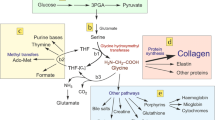Summary
Rabbit articular chondrocytes in monolayer culture are modulated away from their differentiated state and undergo morphological and biochemical changes. One of the characteristics of the modulated state is an abnormally high production of the cysteine endopeptidase cathepsin B. Addition to chondrocyte cultures of the protein biosynthesis inhibitor, cycloheximide, resulted in a concentration-dependent reduction of cathepsin B secretion, which was fully restored after removal of cycloheximide. Glycosaminoglycans added to the culture medium of modulated chondrocytes partially reduced the rate of secretion of cathepsin B, this effect being dependent on their structure, the degree of sulfation, and concentration. The age of the chondrocytes and the duration of the treatment also influenced this response. The switching off of cathepsin B release was apparently best favored by a high concentration of negatively charged sulfate groups attached to a polymeric glycosaminoglycan chain; this simulates the natural environment of the chondrocytes in articular cartilage.
Similar content being viewed by others
References
Avila JL, Convit J (1975) Inhibition of leucocytic lysosomal enzymes by glycosaminoglycans in vitro. Biochem J 152:57–64
Baici A, Lang A, Hörler D, Knöpfel M (1988) Cathepsin B as a marker of the dedifferentiated chondrocyte phenotype. Ann Rheum Dis 47:684–691
Bayliss MT, Ali SY (1978) Studies on cathepsin B in human articular cartilage. Biochem J 171:149–154
Benya PD, Brown PD (1986) Modulation of the chondrocyte phenotype in vitro. In: Kuettner KE, Schleyerbach R, Hascall VS (eds) Articular cartilage biochemistry. Raven Press, New York, pp 219–233
Benya PD, Padilla SR (1986) Modulation of the rabbit chondrocyte phenotype by retinoic acid terminates type II collagen synthesis without inducing type I collagen: the modulated phenotype differs from that produced by subculture. Dev Biol 118:296–305
Benya PD, Shaffer JD (1982) Dedifferentiated chondrocytes reexpress the differentiated collagen phenotype when cultured in agarose gels. Cell 30:215–224
Benya PD, Brown PD, Padilla SR (1988) Microfilament modification by dihydrocytochalasin B causes retinoic acid-modulated chondrocytes to reexpress the differentiated collagen phenotype without a change in shape. J Cell Biol 106:161–170
Bretton RH, Pennypacker JP (1989) Butyric acid causes morphological changes in cultured chondrocytes through alterations in the extracellular matrix. J Cell Physiol 138:197–204
Caskey CT (1973) Inhibitors of protein synthesis. In: Hochster RM, Kates M, Quastel JH (eds) Metabolic inhibitors. Academic Press, New York, pp 131–177
Casu B, Petitou M, Provasoli M, Sinaÿ P (1988) Conformational flexibility: a new concept for explaining binding and biological properties of iduronic acid-containing glycosaminoglycans. Trends Biochem Sci 13:221–225
Handley CJ, Lowther DA (1979) Extracellular matrix metabolism by chondrocytes. 5. The proteoglycans and glycosaminoglycans synthesized by chondrocytes in high density cultures. Biochim Biophys Acta 582:234–245
Huang D (1974) Effect of extracellular chondroitin sulfate on cultured chondrocytes. J Cell Biol 62:881–886
Mark K von der (1982) Collagen synthesis in chondrocyte cultures under the influence of Arteparon (R). In: Dettmer N, Greiling H (eds) International drug symposium Arteparon (R). Eular, Basle, pp 39–49
Mayne R, Vail MS, Mayne PM, Miller EJ (1976) Changes in type of collagen synthesized as clones of chick chondrocytes grow and eventually lose division capacity. Proc Natl Acad Sci USA 73:1674–1678
Michelacci YM, Dietrich CP (1986) Structure of chondroitin sulphate from whale cartilage: distribution of 6- and 4-sulphated oligosaccharides in the polymer chains. Int J Biol Macromol 8:108–113
Nevo Z, Dorfman A (1972) Stimulation of chondromucoprotein synthesis in chondrocytes by extracellular chondromucoprotein. Proc Natl Acad Sci USA 69:2069–2072
Nishikawa H, Mori I, Umemoto J (1985) Influences of sulfated glycosaminoglycans on biosynthesis of hyaluronic acid in rabbit knee synovial membrane. Arch Biochem Biophys 240:146–153
Ronot X, Sene C, Boschetti E, Hartmann DJ, Adolphe M (1984) Culture of chondrocytes in medium supplemented with fetal calf serum or a serum substitute: Ultroser G. Biol Cell 51:307–314
Saito H, Yamagata T, Suzuki S (1968) Enzymatic methods for the determination of small quantities of isomeric chondroitin sulfates. J Biol Chem 243:1536–1542
Saxe SA, Lukens LN, Pawlowski PL (1985) Changes in the nuclear and cytoplasmic levels of type I and type II collagen RNAs during growth of chondrocytes in 5-bromo-2′-deoxyuridine. J Biol Chem 260:3812–3819
Seldin DC, Seno N, Austen KF, Stevens RL (1984) Analysis of polysulfated chondroitin disaccharides by high-performance liquid chromatography. Anal Biochem 141:291–300
Sommarin Y, Heinegård D (1986) Four classes of cell-associated proteoglycans in suspension cultures of articular cartilage chondrocytes. Biochem J 233:809–818
Varner HH, Horn VJ, Martin GR, Hewitt AT (1986) Chondronectin interactions with proteoglycan. Arch Biochem Biophys 244:824–830
Watt FM, Dudhia J (1988) Prolonged expression of differentiated phenotype by chondrocytes cultured at low density on a composite substrate of collagen and agarose that restricts cell spreading. Differentiation 38:140–147
Yasui N, Benya PD, Nimni ME (1986) Coordinate regulation of type IX and type II collagen synthesis during growth of chick chondrocytes in retinoic acid and 5-bromo-2′-deoxyuridine. J Biol Chem 261:7997–8001
Zebrower ME, Kieras FJ, Brown WT (1986) Analysis by highperformance liquid chromatography of hyaluronic acid and chondroitin sulfates. Anal Biochem 157:93–99
Author information
Authors and Affiliations
Additional information
Dedicated to Univ.-Dozent Dr. Karl Chlud on the occasion of his 60th birthday
Rights and permissions
About this article
Cite this article
Baici, A., Lang, A. Cathepsin B secretion by rabbit articular chondrocytes: modulation by cycloheximide and glycosaminoglycans. Cell Tissue Res. 259, 567–573 (1990). https://doi.org/10.1007/BF01740785
Accepted:
Issue Date:
DOI: https://doi.org/10.1007/BF01740785




